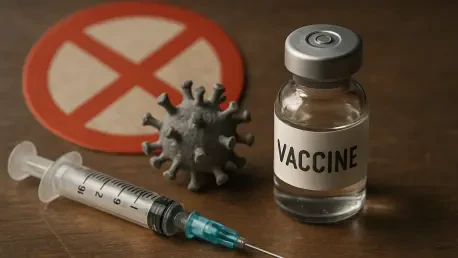I’m thrilled to sit down with Dr. James Maitland, a renowned expert in public health and vaccine science, whose extensive research has shaped our understanding of immunization safety and efficacy. With a career dedicated to unraveling the complexities of vaccine components and their impact on human health, Dr. Maitland is the perfect person to address recent controversies surrounding vaccine ingredients, particularly aluminum adjuvants. In this interview, we dive into the science behind these compounds, explore the validity of claims linking them to health issues, and discuss the broader implications for public trust in vaccination programs.
How do you respond to recent claims that aluminum in vaccines poses a risk to health, potentially contributing to conditions like autism or allergies?
I understand the concern, especially when it comes from a place of wanting to protect loved ones. However, the scientific evidence overwhelmingly shows that aluminum adjuvants in vaccines are safe at the levels used. These claims often stem from misinterpretations of data or anecdotal reports rather than robust, peer-reviewed studies. For instance, extensive research, including large-scale human studies, has found no credible link between aluminum in vaccines and autism or systemic allergies. We’ve been using aluminum adjuvants for nearly a century, and the data consistently supports their safety profile.
Can you walk us through what aluminum adjuvants are and why they’re such a critical part of many vaccines?
Absolutely. Aluminum adjuvants are compounds, like aluminum hydroxide or phosphate, that are added to certain vaccines to enhance the body’s immune response. They act like a booster, helping the immune system recognize and remember the harmless piece of a virus or bacterium in the vaccine. When injected, they create a mild inflammation at the site, which draws immune cells to the area. These cells then learn to identify the target germ, preparing the body to fight it off if encountered later. Without adjuvants, some vaccines, like those for diphtheria or hepatitis B, wouldn’t trigger a strong enough response to provide lasting protection.
There’s been some discussion about animal studies suggesting aluminum adjuvants might contribute to allergies. What’s your perspective on using these studies to draw conclusions about human health?
Animal studies are a valuable starting point for understanding biological mechanisms, but they have significant limitations when applied to humans. In these experiments, researchers often mix aluminum with a food protein to deliberately sensitize mice or rats, which isn’t how vaccines work in people. Vaccines don’t contain food proteins, so there’s no direct pathway for them to cause something like a peanut allergy. Additionally, the immune systems of rodents react differently than ours—mice are far more prone to allergic responses. So, while these studies help us hypothesize, they can’t be directly translated to human risks without further evidence from human data.
Many experts argue that the amount of aluminum in vaccines is negligible compared to everyday exposure. Can you elaborate on how this comparison plays out?
Sure. Aluminum is one of the most common elements on Earth, and we’re exposed to it constantly through food, water, and even air. Over the first 18 years of life, a person naturally takes in about 400 milligrams of aluminum from these sources. In contrast, the total aluminum from a full childhood vaccine schedule is around 8 milligrams— a tiny fraction. Most of this is quickly excreted through the kidneys via urine, so it doesn’t accumulate in the body. When you look at it this way, the concern over vaccine aluminum seems disproportionate compared to what we encounter daily without issue.
A large study from Denmark, involving over a million children, found no link between aluminum in vaccines and childhood diseases, yet it’s been criticized as misleading by some. How do you view the strength of this research?
I think the Danish study is a powerful piece of evidence. It tracked 1.2 million children over two decades using comprehensive national health registries, which minimizes bias and provides a robust dataset. Their finding of no increased risk with higher aluminum exposure aligns with other global research. Criticisms labeling it as propaganda often overlook the study’s methodology and transparency. Science isn’t perfect, but when a study of this scale and rigor shows consistent results, it carries significant weight in informing public health policy and reassuring communities about vaccine safety.
We’ve seen some studies initially suggest a slight link between aluminum and conditions like asthma, only for later analyses to refute it. How should the public make sense of these conflicting findings?
It’s natural for people to feel confused by mixed results, but this is part of how science works. Initial findings might show a weak association due to confounding factors—like breastfeeding habits or environmental exposures—that aren’t fully accounted for at first. When researchers dig deeper, as they did with the asthma study, those associations often disappear. The key is to look at the body of evidence over time, not just one study. Large, well-controlled studies consistently show no causal link, and false signals are common when analyzing huge datasets for multiple outcomes. Patience and critical thinking are crucial when interpreting early results.
What could be the consequences for public health if aluminum adjuvants were removed from vaccines due to these concerns?
Removing aluminum adjuvants would be a massive setback for public health. Many core vaccines, like those for tetanus, hepatitis B, and HPV, rely on these adjuvants to be effective. Without them, we’d need to reformulate vaccines, conduct extensive new clinical trials, and risk production shortages for years. During that time, preventable diseases could surge—think more measles outbreaks or HPV-related cancers. Aluminum adjuvants have hit a sweet spot of being both effective and safe, and replacing them isn’t a simple swap. The real risk isn’t the adjuvant; it’s losing the protection these vaccines provide.
Looking ahead, what is your forecast for the ongoing debate around vaccine ingredients and public trust in immunization programs?
I think this debate will persist as long as misinformation can spread faster than scientific consensus. My forecast is that we’ll see continued efforts to rebuild trust through transparent communication and education. Public health agencies and scientists need to keep engaging directly with communities, addressing fears with empathy while grounding discussions in data. If we can focus on clear, accessible explanations of how vaccines work and why ingredients like aluminum are safe, I believe we can counteract skepticism. But it’s an uphill battle, and the stakes are high—every drop in vaccine uptake risks bringing back diseases we’ve fought so hard to control.









